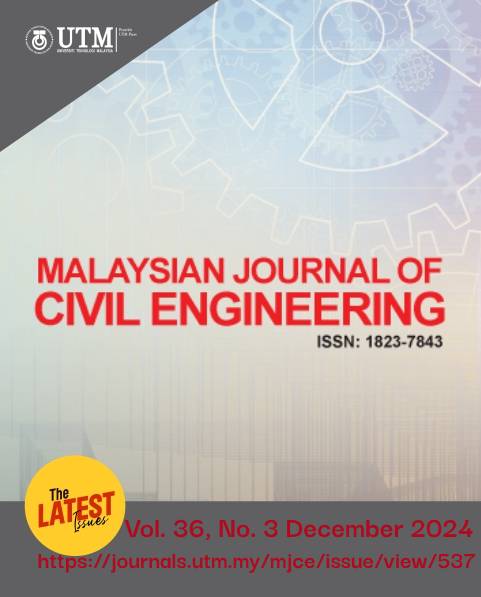INFLUENCE OF PEDESTRIAN ATTRIBUTES ON WALKING SPEED AT BOTTLENECK OF BUS TERMINAL WALKWAY
DOI:
https://doi.org/10.11113/mjce.v36.22576Keywords:
Pedestrian attributes, walking speed, pedestrian behavior, bottleneck, bus terminalAbstract
Walking speed, a fundamental aspect of transportation, varies across individuals and is influenced by factors such as age, gender, and environmental conditions. This study focuses on pedestrian behavior, particularly walking speed, at bottlenecks in Larkin Sentral bus terminal in Johor Bahru, Malaysia. The country's lower average walking speed compared to other Asian nations underscores the need for efficient urban transportation planning. The objectives are to determine pedestrian walking speeds and explore the relationship between pedestrian attributes and walking speed. Data was collected using video recording at selected walkways during peak and non-peak hours. The analysis, conducted using Minitab software, reveals a mean walking speed of 0.80 m/s, influenced by factors such as age, gender, carrying bags, using phones, attire, and time. Correlation analysis indicates that time and phone usage significantly affect walking speed. This study contributes valuable insights for enhancing urban planning, emphasizing the impact of technology and time on pedestrian experiences at bus terminals. The implications for urban transportation planning are substantial, advocating for custom interventions in pedestrian-friendly designs at bus terminals. The study challenges assumptions, highlighting the need for nuanced understanding and further research to comprehend the complex dynamics shaping pedestrian behavior.
References
Adrian, J., Boltes, M., Sieben, A., & Seyfried, A. 2020. Influence of Corridor Width and Motivation on Pedestrians in Front of Bottlenecks. Paper presented at the Springer Proceedings in Physics. DOI:10.1007/978-3-030-55973-1_1
Bargegol, I., Najafi Moghaddam Gilani, V., Hosseinian, S. M., & Habibzadeh, M. 2022. Pedestrians Crossing and Walking Speeds Analysis in Urban Areas under the Influence of Rain and Personality Characteristics. Mathematical Problems in Engineering, 2022. DOI:10.1155/2022/7768160
Cao, S., Xi, X., Ni, J., & Yao, M. 2022. Simulation of pedestrian flow at bottleneck of stairs considering group behavior. China Safety Science Journal, 32(2), 28-33. DOI:10.16265/j.cnki.issn1003-3033.2022.02.005
Dai, J., Li, X., & Liu, L. 2013. Simulation of pedestrian counter flow through bottlenecks by using an agent-based model. Physica A: Statistical Mechanics and its Applications, 392(9): 2202-2211. DOI:10.1016/j.physa.2013.01.012
Dias, C., Sarvi, M., Shiwakoti, N., & Ejtemai, O. 2013. Experimental study on pedestrian walking characteristics through angled corridors. Paper presented at the Australasian Transport Research Forum, ATRF 2013 - Proceedings.
Ekawati, F. F., & Eves, F. F. 2020. Effects of climbing choice, demographic, and climate on walking behavior. Kesmas, 15(2): 59-64. DOI:10.21109/KESMAS.V15I2.2909
Figueroa-Medina, A. M., Valdés-Díaz, D., Colucci-Ríos, B., Cardona-Rodríguez, N., & Chamorro-Parejo, A. 2023. Analysis of walking speeds and success rates on mid-block crossings using virtual reality simulation. Accident Analysis and Prevention, 183. DOI:10.1016/j.aap.2023.106987
Franěk, M. 2013. Environmental factors influencing pedestrian walking speed. Perceptual and motor skills, 116(3): 992-1019.
Fugger Jr, T. F., Randles, B. C., Wobrock, J. L., Stein, A. C., & Whiting, W. C. 2001. Pedestrian behavior at signal-controlled crosswalks. Paper presented at the SAE Technical Papers. DOI:10.4271/2001-01-0896
Giacomini, C., Longo, G., & Zornada, M. (2017). Pedestrian infrastructure: Design optimization and performance. Paper presented at the GSTF Conference Proceeding.
Guío-Burgos, F. A., Combariza-Pinzón, M. J., & Cerquera-Escobar, F. Á. 2023. Pedestrian gaps and walking speed at uncontrolled midblock crosswalks. Revista Facultad de Ingenieria. 107: 26-38. DOI:10.17533/udea.redin.20220371
Hassouna, F. M. A. 2020. Evaluation of pedestrian walking speed change patterns at crosswalks in Palestine. Open Transportation Journal, 14: 44-49. DOI:10.2174/1874447802014010044
Iryo-Asano, M., & Alhajyaseen, W. 2017. Consideration of a Pedestrian Speed Change Model in the Pedestrian-Vehicle Safety Assessment of Signalized Crosswalks. Paper presented at the Transportation Research Procedia. DOI:10.1016/j.trpro.2017.03.080
Khudhair, H. A., & Alsadik, S. M. 2021. Modeling the pedestrians walking behaviour at a commercial center in Baghdad City. Journal of Engineering Science and Technology, 16(4): 3104-3118.
Kim, S. H., Kim, J. W., Chung, H. C., Choi, G. J., & Choi, M. Y. 2020. Behavioral dynamics of pedestrians crossing between two moving vehicles. Applied Sciences (Switzerland), 10(3): DOI:10.3390/app10030859
Li, M., Zhou, Z., Zhou, X., Zhang, P., Cheng, H., Jiang, J., Yang, L. 2022. How bottleneck width and restricted walking height affect pedestrian motion: Experimental analysis. Physica A: Statistical Mechanics and its Applications, 605. DOI:10.1016/j.physa.2022.127967
Ma, Z. Y., Zhang, J. X., Philbin, S. P., Li, H., Yang, J., Feng, Y. L., Skitmore, M. 2021. Dynamic Quality Monitoring System to Assess the Quality of Asphalt Concrete Pavement. Buildings, 11(12) DOI:10.3390/buildings11120577
Matsuura, T., & Yano, N. (2023). Behaviors of pedestrians on streets with roadside strips. Transportation Research Interdisciplinary Perspectives, 19. DOI:10.1016/j.trip.2023.100799
Mustafa, M., Baser, N., & Ashaari, Y. 2014. Evaluating pedestrian crossing speed distribution: A case study of Shah Alam. Paper presented at the IET Conference Publications.
Mustafa, M., Noor, M., & Mohamad, A. I. 2015. Understanding pedestrian movement at rail transit station ticketing gate. Paper presented at the Conference of Eastern Asia society for transportation studies.
Papadimitriou, E., Yannis, G., & Golias, J. 2016. Analysis of Pedestrian road crossing behaviour in urban areas Civil and Environmental Engineering: Concepts, Methodologies, Tools, and Applications. 3: 1140-1155.
Pinna, F., & Murrau, R. 2018. Age factor and pedestrian speed on sidewalks. Sustainability (Switzerland), 10(11) DOI:10.3390/su10114084
Rosenbloom, T., Beigel, A., & Eldror, E. 2011. Attitudes, behavioral intentions, and risk perceptions of fatigued pedestrians. Social Behavior and Personality: an international journal, 39(9): 1263-1270.
Sukhadia, H., Dave, S. M., Shah, J., & Rathva, D. 2016. The Effect of Events on Pedestrian Behavior and its Comparison with Normal Walking Behavior in CBD Area in Indian Context. Paper presented at the Transportation Research Procedia. DOI:10.1016/j.trpro.2016.11.120
Zhou, J. B., Chen, H., Yan, B., & Zhu, H. J. 2014. Pedestrian traffic characteristics analysis in the metro transfer hub. Wuhan Ligong Daxue Xuebao/Journal of Wuhan University of Technology, 36(4): 92-99. DOI:10.3963/j.issn.1671-4431.2014.04.017
Zhuang, X., & Wu, C. 2011. Modeling of pedestrian crossing behavior at unmarked roadway in China. Paper presented at the ICTIS 2011: Multimodal Approach to Sustained Transportation System Development - Information, Technology, Implementation - Proceedings of the 1st Int. Conf. on Transportation Information and Safety. DOI:10.1061/41177(415)223
















